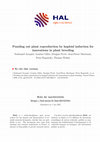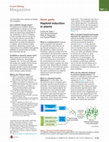Papers by Jean-pierre Martinant

Theoretical and Applied Genetics, Oct 22, 2004
Polymorphisms within three candidate genes for lignin biosynthesis were investigated to identify ... more Polymorphisms within three candidate genes for lignin biosynthesis were investigated to identify alleles useful for the improvement of maize digestibility. The allelic diversity of two caffeoyl-CoA 3-O-methyltransferase genes, CCoAOMT2 and CCoAOMT1, as well as that of the aldehyde O-methyltransferase gene, AldOMT, was evaluated for 34 maize lines chosen for their varying degrees of cell wall digestibility. Frequency of nucleotide changes averaged one SNP every 35 bp. Ninety-one indels were identified in non-coding regions and only four in coding regions. Numerous distinct and highly diverse haplotypes were identified at each locus. Numerous sites were in linkage disequilibrium that declined rapidly within a few hundred bases. For F4, an early flint French line with high cell wall digestibility, the CCoAOMT2 first exon presented many non-synonymous polymorphisms. Notably we found an 18-bp indel, which resembled a microsatellite and was associated with cell wall digestibility variation. Additionally, the CCoAOMT2 gene co-localized with a QTL for cell wall digestibility and lignin content. Together, these results suggest that genetic diversity investigated on a broader genetic basis could contribute to the identification of favourable alleles to be used in the molecular breeding of elite maize germplasm.
HAL (Le Centre pour la Communication Scientifique Directe), Dec 5, 2000
INRA UMR Amélioration et santé ds plantes 63039 Clermont6ferrand (FRA) Diffusion du document : IN... more INRA UMR Amélioration et santé ds plantes 63039 Clermont6ferrand (FRA) Diffusion du document : INRA UMR Amélioration et santé ds plantes 63039 Clermont6ferrand (FRA)absen

Theoretical and Applied Genetics, Sep 8, 2017
genotyped using a custom Axiom TM Affymetrix SNP array. A high-quality consensus map was also con... more genotyped using a custom Axiom TM Affymetrix SNP array. A high-quality consensus map was also constructed, allowing the linkage disequilibrium present in the germplasm to be investigated. Using the complete SNP array, genomic prediction accuracies were found to be substantially higher than those previously observed in smaller populations and also more accurate compared to prediction approaches using a finite number of selected quantitative trait loci. Multi-trait genetic correlations were also assessed at an additive and residual genetic level, identifying a negative genetic correlation between grain yield and protein as well as a positive genetic correlation between grain size and test weight. (MAS) (Koebner and Summers 2003; Collard and Mackill 2008). Early statistical modelling approaches to QTL mapping involved the analysis of individual markers through simple scanning procedures (Soller et al. 1976). In more Abstract Key message Genomic prediction accuracy within a large panel was found to be substantially higher than that previously observed in smaller populations, and also higher than QTL-based prediction.

Food and Agricultural Immunology, Mar 1, 2000
Gliadin and glutenin contents are known to affect gluten functional properties. ELISA tests, whic... more Gliadin and glutenin contents are known to affect gluten functional properties. ELISA tests, which are rapid and easy to perform, can provide very convenient methods for industrial quality control. The purpose of this study was to develop a competitive ELISA for quantification of gliadins in wheat flour and compare the results with those obtained by nitrogen and reverse-phase high-performance liquid chromatography (RP-HPLC) determination of gliadin content after sequential extraction. As a b-gliadin and total gliadin contents are highly correlated, polyclonal antibodies directed against the C-terminal peptide of a b-gliadins were used in a sequential competitive ELISA to quantify total gliadins. In 21 flour samples, the results with ELISA were closely correlated with those obtained by nitrogen and RP-HPLC determinations (r > 0.82, P < 0.001), indicating that the ELISA test based on detection of a b-gliadins allowed fairly accurate quantification of total gliadins. Immunoblotting analysis after acid-PAGE showed that some b-gliadin components were poorly detected or undetected by the antiserum, which could account for differences between the immunochemical and biochemical values observed for a few cultivars.

Nature plants, Jun 8, 2020
Mixing maternal and paternal genomes in embryos is not only responsible for the evolutionary succ... more Mixing maternal and paternal genomes in embryos is not only responsible for the evolutionary success of sexual reproduction but a cornerstone of plant breeding. However, once an interesting gene combination is obtained, further genetic mixing is problematic. To rapidly fix genetic information, doubled-haploid plants can be produced: haploid embryos having solely the genetic information from one parent are allowed to develop and chromosome doubling generates fully homozygous plants. A powerful path to doubledhaploids production is based on haploid inducer lines. A simple cross between a haploid inducer line and the line with gene combinations to be fixed will trigger haploid embryo development. However the exact mechanism behind in-planta haploid induction remains an enduring mystery. The recent discoveries of molecular actors triggering haploid induction in the maize crop and the model Arabidopsis thaliana pinpoint an essential role of processes related to gamete development, gamete interactions and genome stability. These findings enabled translation of haploid induction capacity to other crops, and the use of haploid inducer lines to deliver genome editing machinery into various crop varieties. These recent advances not only hold promise for the next generations of plant breeding strategies, but it also provides a deeper insight into the fundamental bases of sexual reproduction in plants.
HAL (Le Centre pour la Communication Scientifique Directe), Sep 15, 2021
International audienc

Journal of the Science of Food and Agriculture, May 1, 1998
ABSTRACT Wheat storage proteins are responsible for the viscoelastic properties of dough. Their e... more ABSTRACT Wheat storage proteins are responsible for the viscoelastic properties of dough. Their effect on dough rheology depends on the glutenin components and the proportion of gliadins, high and low molecular weight glutenin subunits (HMW-GS, LMW-GS). A prediction of dough behaviour is possible when the concentration of each prolamin group is known. A method of sequential extraction and quantification of wheat flour proteins was developed. Reversed-phase high-performance liquid chromatography (RP-HPLC) was used to quantify gliadins and HMW-GS and LMW-GS. Non-prolamin proteins and lipids were extracted with phosphate buffer and phosphate buffer containing Triton X114 respectively and 70% (v/v) ethanol was used to extract gliadins. Several solvent systems were tested to exhaustively extract glutenins and a buffer containing 0·05 M tetraborate pH 8·5, 2% (v/v) 2-mercaptoethanol, 1 g litre−1 glycine, and 8 M urea was selected. It facilitated the most complete extraction and was compatible with RP-HPLC analysis of extracts. The quantities of extracted prolamins were estimated from RP-HPLC profiles using peak area determination. The concentration of different classes of prolamins obtained by RP-HPLC was compared with their determination by nitrogen (N) content. The average yield of extractions performed on 45 cultivars was 0·99 (coefficient of variation (CV)=7·6%) for gliadins and 0·89 (CV=9·1%) for glutenins. Quantifications of proteins by N determination and RP-HPLC were strongly correlated: regression coefficients were 0·86 for total prolamins and gliadins, and 0·71 for glutenins with the gradient of regression of approximately 1. Therefore, RP-HPLC could be used to quantify prolamin groups without using N determination. © 1998 SCI.
Plant Physiology, Jun 10, 2023

Phospholipases are ubiquitous enzymes that cleave phospholipids, one major constituent of membran... more Phospholipases are ubiquitous enzymes that cleave phospholipids, one major constituent of membranes. They are thus essential for many developmental processes, including male gamete development. In flowering plants, mutation of phospholipase NOT-LIKE-DAD (NLD) leads to peculiar defects in sexual reproduction. Indeed, pollination of a wild-type female with mutant pollen generates haploid embryos containing solely maternal genetic information. Contrary to previous reports NLD does not localize to cytosol and plasma membrane (PM) of sperm cells but to the pollen endo-plasma membrane (endo-PM), a specific membrane derived from the PM of the pollen vegetative cell that encircles the two sperm cells. Pharmacological approaches coupled with targeted mutagenesis revealed that lipid anchoring together with electrostatic interactions between membrane and NLD are involved in the attachment of NLD to this atypical endo-PM. Membrane surface-charge and anionic lipid bio-sensors indicated that phosphatidylinositol-4,5-bisphosphate (PIP(4,5)P 2) is enriched in the endo-PM as compared to the PM. Our results uncover a unique example of how membrane electrostatic properties can specify a unique polar domain (i.e. endo-PM), which is critical for plant reproduction and gamete formation. keywords: maize / phospholipase / plasma membrane / pollen / sperm cell (which was not certified by peer review) is the author/funder. All rights reserved. No reuse allowed without permission. not only represents an interesting resource to study pollen development and plant reproduction but also a powerful plant breeding tool (Jacquier et al, 2020; Gilles et al, 2017b). Maize breeders have capitalized on this reproductive anomaly, through gynogenesis: after genome doubling of haploid embryos/plantlets, breeders can produce "doubled haploid" plants that are homozygous at all loci in only two generations, compared to the traditional 7 generations of backcrossing or selfing (Jacquier et al, 2020; Kalinowska et al, 2019). The gene MATRILINEAL / NOT LIKE DAD / ZmPHOSPHOLIPASE-A (for simplification designated NLD hereafter) was recently found to cause the haploid induction (Kelliher et al, 2017; Gilles et al, 2017a; Liu et al, 2017). Sequence analysis revealed that NLD belongs to the patatin-like phospholipase family (Gilles et al, 2017a). The patatin catalytic domain is widely spread in bacteria, yeast, plants and animals, and members of this group are involved in diverse cellular functions (

Journal of Cell Biology, Jul 29, 2021
Phospholipases cleave phospholipids, major membrane constituents. They are thus essential for man... more Phospholipases cleave phospholipids, major membrane constituents. They are thus essential for many developmental processes, including male gamete development. In flowering plants, mutation of phospholipase NOT-LIKE-DAD (NLD, also known as MTL or ZmPLA1) leads to peculiar defects in sexual reproduction, notably the induction of maternal haploid embryos. Contrary to previous reports, NLD does not localize to cytosol and plasma membrane of sperm cells but to the pollen endo-plasma membrane (endo-PM), a specific membrane derived from the PM of the pollen vegetative cell that encircles the two sperm cells. After pollen tube burst, NLD localizes at the apical region of the egg apparatus. Pharmacological approaches coupled with targeted mutagenesis revealed that lipid anchoring together with electrostatic interactions are involved in the attachment of NLD to this atypical endo-PM. Membrane surface-charge and lipid biosensors indicated that phosphatidylinositol-4,5-bisphosphate is enriched in the endo-PM, uncovering a unique example of how membrane electrostatic properties can define a specific polar domain (i.e., endo-PM), which is critical for plant reproduction and gamete formation.

Current Biology, Oct 1, 2017
communication as a channel concealed from predators. Can cuttlefi sh change shape? The absence of... more communication as a channel concealed from predators. Can cuttlefi sh change shape? The absence of a skeleton allows cephalopods to change not only their coloration but also their shape to an extent far beyond the capabilities of any vertebrate. In 2012 in Thailand, a diver recorded what he thought to be a hermit crab but was actually a cuttlefi sh. More recently, Japanese researchers recorded this behaviour in captive, naïve juveniles of Sepia pharaonis. Mimicking a hermit crab might protect the cuttlefi sh itself against predators or deceive prey by looking like a harmless animal. Cuttlefi sh in research, what's next? Much remains to be learned about cuttlefi sh behaviour, camoufl age, cognition, etc. For this, both fi eld and lab studies are needed, but the former are scarce. Comparative studies between species must be encouraged. Meeting this fascinating animal in the wild is always a great moment. Where can I fi nd out more?
Journal of Cereal Science, Jul 1, 1999

Le poids economique de la panification a oriente la selection des varietes de ble tendre francais... more Le poids economique de la panification a oriente la selection des varietes de ble tendre francaises vers des caracteristiques technologiques de moins en moins adaptees a la biscuiterie. L'objectif de cette these est d'identifier les caracteristiques biochimiques et technologiques des farines qui soient discriminantes pour la qualite biscuitiere, afin de developper des programmes de selection de varietes adaptees a la biscuiterie. Un biscuit sec de type lamine decoupe, similaire au gouter fabrique par le test du ctuc (qui est utilise pour l'inscription des varietes biscuitieres par le ctps), a ete choisi pour ce travail. Une population de 39 varietes de ble a permis la recherche des caracteristiques biochimiques et technologiques associees aux variations de reponse des farines au test biscuitier. Il apparait que la durete du grain (gh) est la variable la plus explicative de la qualite biscuitiere, suivie par la mesure de viscosite des extraits aqueux de farine, av (qui correspond approximativement a la viscosite des arabinoxylanes hydrosolubles). Les quantites de sous-unites de glutenines de haut poids moleculaire et de proteines totales sont egalement retrouvees dans l'explication des variables du test biscuitier. De faibles valeurs, a la fois pour gh et av, semblent associees a une meilleure qualite biscuitiere. Une etude sur 50 lignees issues d'un croisement entre deux varietes (floreal et capitole), de durete et de viscosite faibles, confirme ces resultats. Un lot de 19 varietes, experimentees sur trois lieux differents, a permis d'apprecier l'heritabilite des parametres du test biscuitier et celle de variables associees a la qualite. De fortes valeurs d'heritabilite ont ete obtenues pour plusieurs variables associees a la qualite biscuitiere (gh et av) et pour certains parametres du test biscuitier. Une etude genetique, a partir de deux croisements cartographies issus de varietes parentales d'origine tres diverse, a permis de confirmer le qtl majeur sur le chromosome 5ds pour gh et de reveler un qtl majeur, localise sur le chromosome 1bl, pour av. Ces resultats sont encourageants pour la selection de varietes de ble tendre adaptees a la biscuiterie de type biscuit sec. Les resultats de biologie moleculaire pourraient permettre d'envisager des programmes de selection assistee par marqueurs moleculaires.
HAL (Le Centre pour la Communication Scientifique Directe), 2008
HAL is a multidisciplinary open access archive for the deposit and dissemination of scientific re... more HAL is a multidisciplinary open access archive for the deposit and dissemination of scientific research documents, whether they are published or not. The documents may come from teaching and research institutions in France or abroad, or from public or private research centers. L'archive ouverte pluridisciplinaire HAL, est destinée au dépôt et à la diffusion de documents scientifiques de niveau recherche, publiés ou non, émanant des établissements d'enseignement et de recherche français ou étrangers, des laboratoires publics ou privés.
HAL (Le Centre pour la Communication Scientifique Directe), Nov 25, 1996
HAL (Le Centre pour la Communication Scientifique Directe), Nov 25, 1996
The excel sheet contains the genomic data and the phenotypic dat

Maydica, 2018
The old INRA flint early line F4, which belongs to the northern flint group, is typified by its h... more The old INRA flint early line F4, which belongs to the northern flint group, is typified by its high cell wall digest- ibility which reaches values as high as those observed in several brown-midrib bm3 mutant lines. The F4 line thus appeared as a model that could contribute to the understanding of genetic mechanisms involved in variation of secondary wall traits. Different strategies and results were thus gathered including especially cell wall biochemical and digestibility investigations, expression approaches, QTL investigations, and colocalizations between QTLs and candidate genes. Lignin content was lower in F4 than in other lines, with a tendency to lower p-coumarate content. The Syringyl/Guaiacyl lignin unit ratio was similar in F4 as in other lines, but this ratio was nearly not reduced in F4bm3, conversely to what is observed in bm3 mutants. In comparison with the INRA F2 control line, expressions of three PAL genes including the ZmPAL, of the ZmF5H1 and the ZmCOMT genes wer...

Theoretical and Applied Genetics, 2004
Polymorphisms within three candidate genes for lignin biosynthesis were investigated to identify ... more Polymorphisms within three candidate genes for lignin biosynthesis were investigated to identify alleles useful for the improvement of maize digestibility. The allelic diversity of two caffeoyl-CoA 3-O-methyltransferase genes, CCoAOMT2 and CCoAOMT1, as well as that of the aldehyde O-methyltransferase gene, AldOMT, was evaluated for 34 maize lines chosen for their varying degrees of cell wall digestibility. Frequency of nucleotide changes averaged one SNP every 35 bp. Ninety-one indels were identified in non-coding regions and only four in coding regions. Numerous distinct and highly diverse haplotypes were identified at each locus. Numerous sites were in linkage disequilibrium that declined rapidly within a few hundred bases. For F4, an early flint French line with high cell wall digestibility, the CCoAOMT2 first exon presented many non-synonymous polymorphisms. Notably we found an 18-bp indel, which resembled a microsatellite and was associated with cell wall digestibility variation. Additionally, the CCoAOMT2 gene co-localized with a QTL for cell wall digestibility and lignin content. Together, these results suggest that genetic diversity investigated on a broader genetic basis could contribute to the identification of favourable alleles to be used in the molecular breeding of elite maize germplasm.











Uploads
Papers by Jean-pierre Martinant